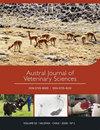在墨西哥北部的集约化生产系统中,在限制饲养计划下使用整体饲料育肥羔羊
IF 0.5
4区 农林科学
Q3 VETERINARY SCIENCES
引用次数: 3
摘要
本研究的目的是比较在限制饲喂方案下使用整体日粮的育肥羊的生产性能。采用完全随机区组设计,按活重和年龄将10只杜泊羔羊分为2个均匀组。1组饲喂生产者常用的传统饲粮,2组饲喂以羔羊干物质需要量75%为限的综合饲料。评价变量为:干物质采食量、初、末活重、日增重、饲料效率和以身高、体长、胸径、蔗长、蔗宽表示的体生长。进行了部分成本分析,以评估经济可行性。与传统饲粮相比,饲喂整体饲料的羔羊具有更好的饲料效率、更高的干物质采食量、日增重、身高、体长和胸径。在限制饲养计划下使用一种综合饲料,每头羔羊的肥育成本降低了2.46美元,肥育期缩短了120天。总的来说,在限制饲养计划下提供整体饲料是改善墨西哥北部集约化条件下育肥羔羊的可行替代方案。本文章由计算机程序翻译,如有差异,请以英文原文为准。
Finishing lambs using an integral feed under a restricted-feeding program in an intensive production system in Northern Mexico
The objective of this study was to compare the productive performance of finishing lambs using an integral diet under a restricted-feeding program. Ten Dorper lambs were assigned to two homogenous groups according to live weight and age under a complete randomised block design. Group 1 was fed a traditional diet commonly used by the producer and group 2 was fed an integral feed restricted to 75% of dry matter requirement of lambs. The evaluated variables were: dry matter intake, initial and final live weight, daily weight gain, feed efficiency and body growth expressed in height, body length, thoracic diameter, cane length and cane width. A partial cost analysis was carried out to evaluate the economic viability. Lambs fed with the integral feed had better feed efficiency, higher dry matter intake, daily weight gain, height, body length and thoracic diameter when compared with the lambs fed the traditional diet. The use of an integral feed under a restricted-feeding program reduced the cost of finishing lambs by 2.46 dollars per head and finishing length by 120 days. Overall, providing an integral feed under a restricted-feeding program is a viable alternative for improving finishing lambs under intensive conditions in the Northern Mexico.
求助全文
通过发布文献求助,成功后即可免费获取论文全文。
去求助
来源期刊

Austral Journal of Veterinary Sciences
Veterinary-General Veterinary
CiteScore
1.60
自引率
0.00%
发文量
18
期刊介绍:
Austral Journal of Veterinary Sciences (formerly Archivos de Medicina Veterinaria) publishes original scientific contributions in English, containing the latest developments and discoveries in veterinary sciences. The journal covers topics such as animal health and production, preventive medicine, zoonosis, pharmacology and therapeutics, methods of diagnosis, and other areas related to the veterinary field.
Austral Journal of Veterinary Sciences aims to divulge information about advances in veterinary medicine among universities, research centres, industries, government agencies, biologists, agronomists and veterinarians.
 求助内容:
求助内容: 应助结果提醒方式:
应助结果提醒方式:


